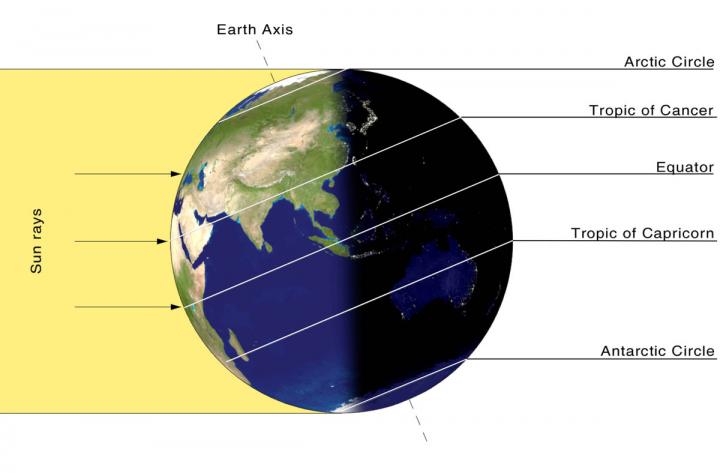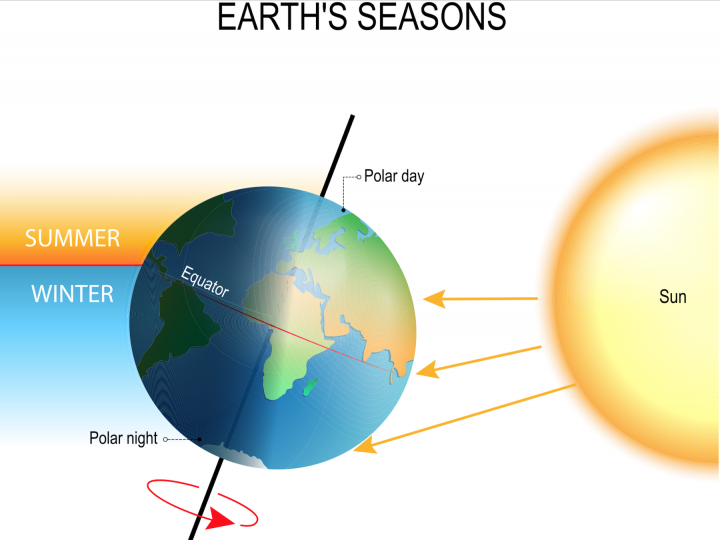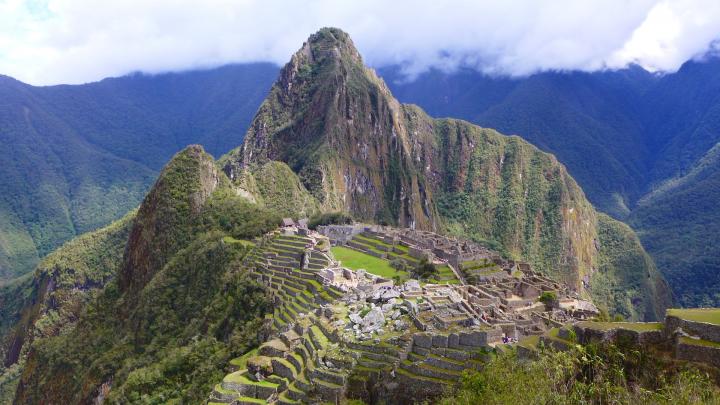Many folks assume the four seasons happen because the Earth is closer to the Sun in the summer (so it’s hotter) and then farther from the Sun in the winter (so it’s colder). This is incorrect. Learn what causes the seasons.
It’s the Earth’s tilted axis that causes the seasons. In fact, winter is when Earth is closest to the Sun (and vice versa).
In one year, Earth revolves completely around the Sun while rotating on an invisible axis, like a tilted, spinning top.
- At one end of the axis is the North Pole; at the other, the South Pole.
- The axis is tilted at a 23.5-degree angle away from the Sun during winter in the Northern Hemisphere; it’s the opposite during summer.

The equator is an imaginary line dividing Earth into the Northern and Southern Hemispheres.
- On 2 days each year, on or around March 20 and September 22, the Sun is directly above the equator. In the Northern Hemisphere, spring starts on the March date, which is called the vernal equinox; fall begins on the September date, which is called the autumnal equinox.
- Summer in the Northern Hemisphere begins on or around June 20, the summer solstice, when the Sun is directly above an imaginary line 23.5 degrees north of the equator called the Tropic of Cancer.
- Winter begins on or around December 21, the winter solstice, when the Sun is above the Tropic of Capricorn, 23.5 degrees south of the equator. The seasons are the opposite in the Southern Hemisphere.

The Long and Short of It
- The summer solstice is one of the longest days of the year in the Northern Hemisphere—and the day when there is no sunlight at the South Pole.
- The winter solstice is one of the shortest days of the year in the Northern Hemisphere—and the day when there is no sunlight at the North Pole.
- Daytime and nighttime on the equinoxes are not equal; this is a myth. However, within a few days of each equinox, there is a day with nearly equal daytime and nighttime. (This depends on the latitude.)
For centuries, people have watched the sky for the changes of season and then celebrated with colorful rituals.
SPRING
In India, many people celebrate the festival of Navroze, or “New Day,” on the spring equinox. It is a day to clean and paint houses, wear new clothes, and hang jasmine flowers and roses on doors and windows.
SUMMER
In ancient times, women and girls in Sweden would bathe in a river in the belief that this would bring plenty of rain for the crops, while village people would dance around a decorated tree. Now, in late June, Swedes dance around a pole covered with greenery and flowers.
AUTUMN
The Chinese mark the end of summer with the Mid-Autumn Moon Festival, which occurs when the Moon is at its brightest. After dark, people stroll with brightly lit lanterns, admire the full Moon, and eat moon cakes, which are pastries with a whole egg yolk in the center, symbolizing the Moon.
WINTER
Ancient Romans welcomed winter with the festival of Saturnalia, honoring Saturn, the god of agriculture. People decorated their houses with evergreen branches and lit lamps all night to ward off the darkness.
Around the time of the solstice, in ancient Scandinavia, people hung mistletoe and evergreens in doorways for good luck and then gathered around bonfires to listen to singing poets. They believed that the fires would help the Sun shine more brightly.

Ancient Sites Marking the Seasons
From ancient times through today, people visit monuments or markers that celebrate the relation between the Sun and the seasons. See five famous ancient seasonal markers.













Comments